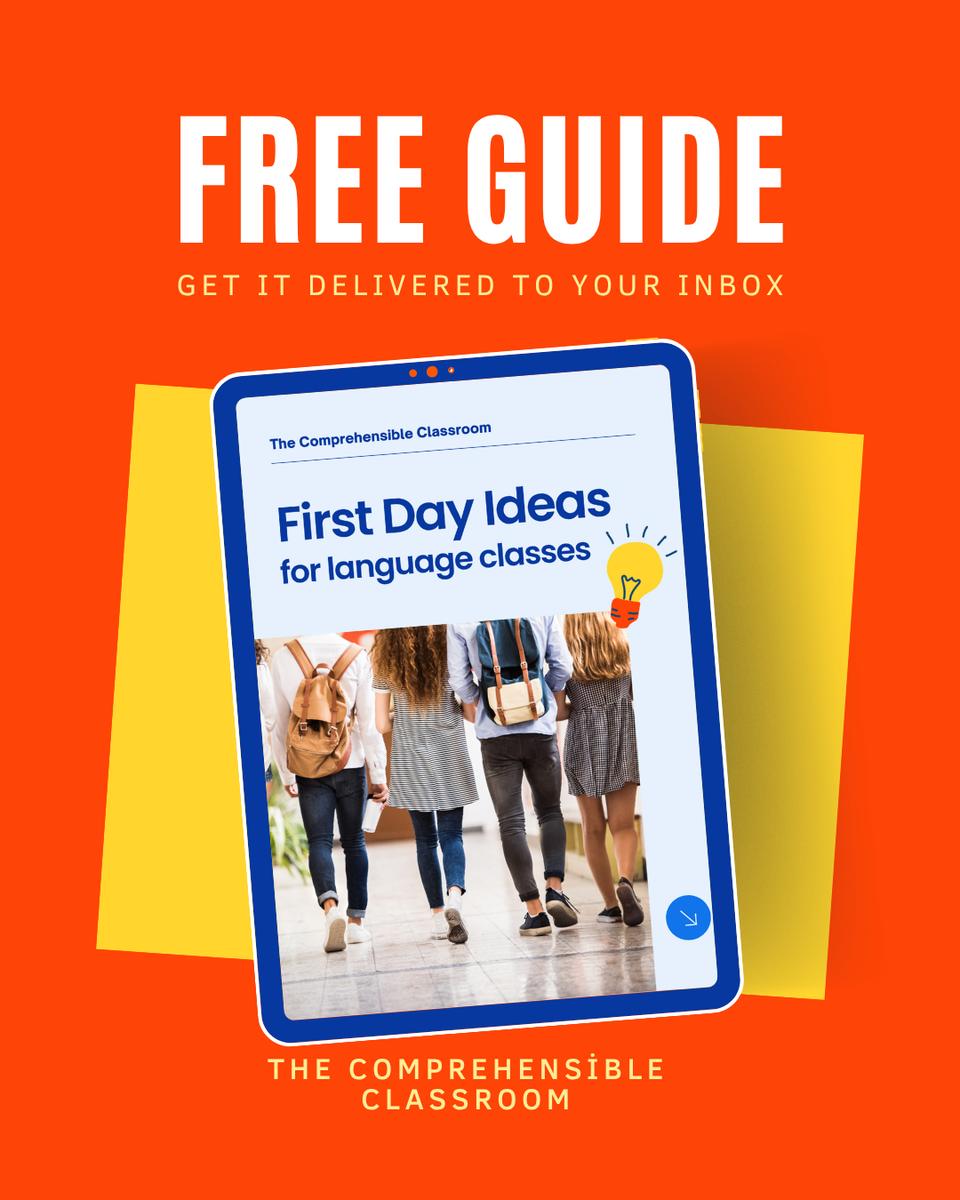That's right...we went back to school yesterday! It feels like I never left, but we've been gone since the end of May. My goal for the first day is to leave students feeling smart and successful and with a fun, unique experience! We have 50 minute periods at my middle school.  Preparation and entering the room
Preparation and entering the room
- To assign seats on the first day, try this.
- I place a Name card at each students' seat, printed on cardstock so that it is sturdy. There are boxes of markers spread around the room for easy access.
- On the board, I write the instructions «Escribe tu nombre con un marcador en el papel. Usa tu color favorito» (Write your name with a marker on the paper. Use your favorite color.) If you teach low-level classes, you should illustrate the sentence with picture cues to help students decipher it. For example, put a picture of a marker next to "marcador" and a picture of paper next to "papel". For Level 1, I have «escribe tu nombre - write your name» translated somewhere on the board, as well.)
Level I (No prior language experience)
- Students write their names on the name cards as soon as they find their seats. They may need some encouragement to figure it out and get started, so you'll be bouncing between the doorway (handing out creature cards) and the classroom. Once one or two students figure it out, it's a domino effect as students look around the room.
- Introduce yourself and review the syllabus/classroom procedures. It's important to make expectations clear on Day 1, but try not to spend too much time here. You can spend small amounts of time for the rest of the week highlighting pieces of the syllabus and reviewing the most important information.
- Teach "Los pollitos dicen". I use this Keynote presentation that has images and translations: Los pollitos dicen. I read each line and have students repeat it several times, then teach the gesture and ask them to guess the meaning by interpreting the image and the gesture. After we've gone through all of the lyrics like that, we play the song once (which repeats the lyrics two times). We'll sing this song every day during the first week.
- PQA: here are several options:
- Me llamo [your name]. ¿Cómo te llamas? Éste es [student’s name]. Él/ella se llama [name]. ¿Cómo se llama __ (point to student)? (My name is/what's your name/his/her name is)
- Este color se llama [point to color]. ¿Te gusta el [color]? ¿Prefieres el [color] o el [other color]? (This color is/do you like this color/do you prefer other color?)
- Éste/a es [student’s name]. Él/ella es un muchacho/una muchacha. (Go through a bunch of students giving names and saying whether they are a boy or a girl, then pick new students and ask the class to identify them as muchacho or muchacha.)
The last thing that I do before students leave is to have them hold up their name card in front of them and take their picture. I study the pictures overnight, and I have most names memorized by Day 2! It's been a very successful strategy for me to learn names quickly.
I also give them a homework assignment, which is to complete a Personal Inventory. I use a personalized version of the one created by Carol Gaab, which I believe is available on TPRStorytelling.com (although I can't locate it with their new site layout--maybe you can help?), but you can easily make your own. Download my adapted inventory here. (Update 8/21/2013--this year, I am giving my Syllabus Homework on the first day, and I'm saving the Personal Inventory assignment for Day 2.)
Level 2 and beyond
I follow the same schedule as Spanish A, except I review a song that they already know and like from previous years (instead of «Los pollitos dicen»).
PQA ideas for upper levels:
- ¿Es ___ estar en casa o estar en la escuela? (mejor, más aburrido, más interesante, más difícil, etc.) OR ¿Prefieres estar en casa o en la escuela? (Is it better/more boring/interesting/more diffcult to be at home or school? Which do you prefer?)
- ¿__ en el verano? (Viajaste a otro lugar, fuiste en avión, jugaste al fútbol/videojuegos/con amigos/etc., fuiste a la playa, miraste la televisión, dormiste mucho, comiste helado/hamburguesas/etc.) (Did you travel/go on a plane, play soccer/videogames/with friends, go to the beach, watch TV, sleep a lot, eat ice cream/hamburgers this summer?)
- ¿Cuál fue tu clase más aburrido/más interesante hoy? (Which was your most boring/most interesting class today?)
- ¿Qué tal el primer día de clases? (How was the first day of classe?)
- ¿Qué hiciste en la clase de __ hoy? (matemáticas, ciencias, inglés, etc.) (What did you do in math/science/English class?)
- ¿Estás feliz de regresar a la escuela? ¿Por qué? (Are you happy to come back to school? Why?)
- Muchas escuelas empiezan las vacaciones de verano en mayo, pero regresan a clases en agosto. ¿Prefieres estar de vacación desde junio hasta septiembre, o sería mejor estar de vacación desde mayo hasta agosto? (Many schools start summer vacation in May, but go back to school in August. Do you prefer to be on vacation from June to September or May to August?)
- ¿Cuál fue la mejor parte de tu descanso? (What was the best part of your break?)
- ¿Qué clase será la más ___ para ti este año? (difícil, interesante, divertida, fácil, etc.)
- ¿Qué quieres aprender en la clase de español? (What do you want to learn in Spanish class?)
A Language Teacher's Guide to the First Day of School
Want more ideas? Get our FREE guide to the First Day of School - complete with lesson plan suggestions, links to materials, and more!





